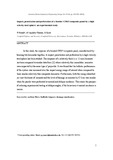- CERES Home
- →
- Cranfield Defence and Security
- →
- Staff publications (CDS)
- →
- View Item
JavaScript is disabled for your browser. Some features of this site may not work without it.
| dc.contributor.author | Hazell, P. J. | |
| dc.contributor.author | Appleby-Thomas, Gareth J. | |
| dc.contributor.author | Kister, G. | |
| dc.date.accessioned | 2011-05-10T23:17:44Z | |
| dc.date.available | 2011-05-10T23:17:44Z | |
| dc.date.issued | 2010-12-31T00:00:00Z | - |
| dc.identifier.issn | 0309-3247 | - |
| dc.identifier.uri | http://dx.doi.org/10.1243/03093247JSA604 | - |
| dc.identifier.uri | http://dspace.lib.cranfield.ac.uk/handle/1826/5316 | |
| dc.description.abstract | In this work, the response of a bonded CFRP composite panel, manufactured by bonding two laminates together, to impact, penetration and perforation by a high-velocity steel sphere has been studied. The response of a relatively thick (c.a. 12 mm) laminate has been compared to similar data from [1] where relatively thin monolithic laminates were impacted by the same type of projectile. It was found that the ballistic performance of the system was increased over the impact energy range of interest when compared to these similar relatively thin composite laminates. Furthermore, both the energy absorbed per-unit-thickness of laminate and the level of damage as measure by C- Scan was similar when the panels were perforated at normal and oblique incidence. This raises the prospect of reducing experimental testing at oblique angles, if the behaviour at normal incidence is known. | en_UK |
| dc.language.iso | en_UK | en_UK |
| dc.publisher | Professional Engineering Publishing | en_UK |
| dc.subject | carbon fibre | en_UK |
| dc.subject | ballistic impact | en_UK |
| dc.subject | damage mechanics | en_UK |
| dc.title | Impact, penetration, and perforation of a bonded carbon-fibre-reinforced plastic composite panel by a high-velocity steel sphere: An experimental study | en_UK |
| dc.type | Article | en_UK |
Files in this item
This item appears in the following Collection(s)
-
Staff publications (CDS) [1209]
